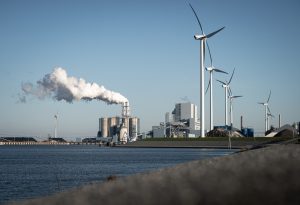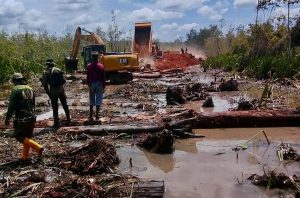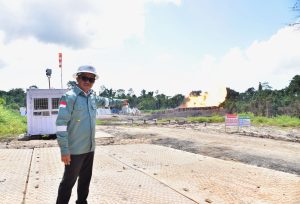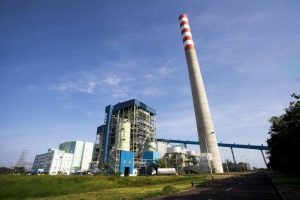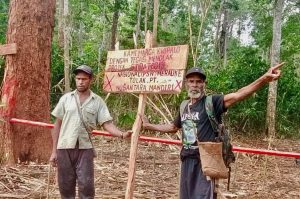Jakarta – The Centre for Research on Energy and Clean Air (CREA) has criticised the biomass co-firing programme in power plants in its latest report, which has been touted as part of the national green energy transition. According to the report published on Friday, 30 May, in addition to very small emission reductions, this scheme has the potential to release hazardous pollutants that have so far escaped regulatory oversight.
CREA’s report titled “Biomass Co-Firing in Indonesia: Prolonging, Not Solving Coal Problems” shows that the implementation of co-firing only reduces emissions by 1.5 to 2.4 per cent of total PLTU emissions. Meanwhile, toxic pollutants, including mercury, carbon monoxide (CO), hydrogen sulfide (H₂S), and heavy metals like arsenic (As) and lead (Pb) have the potential to increase in the environment due to biomass burning without strict supervision.
“CREAʼs findings show that biomass co-firing has virtually no impact on air pollution attributed to coal power generation, such that reductions in health-harming pollutants would be negligible at the current aims,” said Katherin Hasan, CREA analyst.
In the 2021-2023 RUPTL, co-firing schemes that burn up to 10 per cent of biomass, such as sawdust, rice husks, and RDF (Refuse Derived Fuel)-into coal combustion in power plants are targeted to be implemented in 52 power plants across Indonesia.
However, according to CREA, emissions from fine particulate matter (PM) were reduced by only 9 per cent, nitrogen oxides (NOx) by 7 per cent, and sulphur dioxide (SO₂) by only 10 per cent. These figures are considered too small to deal with a national air quality crisis.
These inaccurate claims should serve as an entry point for a more rounded national discussion on air quality, which can only be improved when we recognise the urgency to map a retirement pathway assigned to all coal power plants in Indonesia – on-grid and captive.
More dangerously, according to Katherin, burning biomass with different emission standards than coal can produce toxic compounds that are not regulated under conventional power plant thresholds.
“What’s more, emissions mitigation in coal power plants through the transition decades can only be addressed by stringent emission standards, which would entail the installation of air pollution control technologies in all coal-fired power plants,” she added.
Emission reduction claims are not transparent
One of the main weaknesses in co-firing policies is the lack of comprehensive quantification of overall emissions. Claims of emission reductions are often only calculated from reduced coal use, without considering emissions from the biomass supply chain such as harvesting, drying, processing and transport.
“The main issue with biomass co-firing is that national stakeholders view it as a viable solution to mitigate Indonesia’s fossil fuel emissions rather than truly addressing the root causes of air pollution or prioritising accelerated deployment of renewable energy sources,” said Abdul Baits Swastika, CREA researcher.
He added that without open audits and verification, these claims of co-firing sustainability need to be questioned, and a fact-based roadmap for bioenergy should be provided.
Economic and environmental impacts of biomass supply
From an economic perspective, the biomass purchase price set by PLN only covers low-cost, low-calorie feedstocks, such as agricultural waste or RDF, which have low efficiency when burned. On the other hand, fulfilling the long-term biomass supply triggers the expansion of Energy Plantation Forests (EFs) on large-scale land.
Fiorentina Refani, a researcher from the Centre for Economic and Law Studies (CELIOS), stated that this expansion poses a threat to natural forest areas.
“The sustainability narrative that has been attached to biomass burning is a mere myth … (massive biomass production will be conducted) at the expense of the environment, especially the natural forest, to meet the demand for electricity generation,” she said.
CELIOS noted that currently available biomass will not be able to sustainably meet co-firing needs without a massive expansion of the biomass industry, which risks damaging the environment.
Push for total evaluation and real transition
In this context, CREA calls for a thorough evaluation of the co-firing programme and urges open monitoring and reporting of emissions.
Furthermore, CREA encourages the phase-out of coal-fired power plants and an accelerated transition to renewable energy, including the development of dedicated bioenergy plants designed from the ground up with high efficiency and close oversight.
“It has been several years since biomass co-firing has been offered as a solution, yet there’s no clarity regarding how the biomass will be sourced sustainably and how it can reliably be scaled up, considering the cost and biomass supply. Scrutiny on biomass use is rising in many countries, especially if such risks are not managed,” said Putra Adhiguna, Managing Director at the Energy Shift Institute.
Criticism of biomass co-firing programmes has also come from international energy observers. Putra Adhiguna, Managing Director of the Energy Shift Institute, stated that the global trend indicates a decline in support for biomass as a primary energy source.
“South Korea reportedly ending subsidies for biomass is a telling sign of waning support globally,” said Putra.
Amidst the pressure of the climate crisis and the urgency of reducing air pollution, biomass co-firing programmes are now faced with a fundamental question: is this strategy really bringing Indonesia closer to a clean energy transition, or is it a green illusion that delays real change?
With new risks and data emerging, the public and policymakers are required to look deeper, not just at the emission reduction numbers, but also at the long-term environmental, social and economic consequences of any energy policy taken today. (Hartatik)
Banner photo: South Sumatra 8 Mine Mouth PLTU in Tanjung Lalang Village, Tanjung Agung District, Muara Enim Regency, South Sumatra Province. (Source: PT Bukit Asam Tbk)


